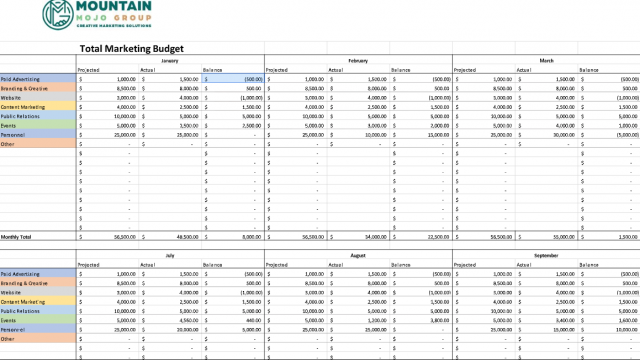The most common question we hear when meeting with a new client is, “Is my marketing working?” Unfortunately, we have to answer that question with another question, ‘How are you keeping track of it?”. And so begins a long and cumbersome conversation about the multitude of different platforms and outlets one can use to market their biz. Well, the first step to sorting through all of that is to look at your budget! How much should you be spending and on what? Creating (and maintaining!) any type of budget is challenging, SO, here are a few tips we find useful, with a downloadable PDF of a custom marketing budget template to get you going and on your way!
Read time: 5 minutes
Tips:
Start with a strategy.
- Begin with your company’s current situation and benchmark your current sales and marketing ROI.
- Define your goals and objectives.
- Make them SMART (Specific, Measurable, Achievable, Relevant, and Timely).
- Define your target personas.
- Create a strategy to obtain your goals, objectives and reach your target personas.
- Your strategy should be consistent with, and reflective of, your goals and visions as a company/business.
- Calculate your cost of acquisition.
Figure out which categories you need to include in your marketing budget.
- Paid Advertising
- Branding/Creative Design
- Web Development/SEO
- Events
- Content
- Public Relations
- Email marketing
Take stock of your team and resources.
- Figure out how much time your team has to dedicate to your marketing efforts.
- Look at what marketing assets and platforms you’re currently using.
- Figure out if you want/need additional marketing assets and platforms.
Research your industry.
- Create a comparative/competitive analysis.
- SWOT Analysis
- Strengths
- Weaknesses
- Opportunities
- Threats
Approach it like a personal budget.
- General good money management skills are key here.
- Don’t spend money you don’t have, even if it doesn’t feel like “your own.”

Don’t put all your eggs in one basket. In other words, diversify.
Don’t spend all your money on one thing, it’s generally always better to allocate some $$ to a variety of marketing channels, especially if you’re just starting out. If you are properly tracking your data, the more marketing avenues you try, the more you’ll know FOR SURE, what’s working and what is not.
Be flexible and open to experimentation.
Check your budget constantly to make sure you are not going over-budget.
Make those cuts when necessary — even when it might feel easier not to.
Every month, stop and reflect. This is time well invested!
Before you continue with your marketing efforts the next month, stop and reflect how your marketing went during the most recent month. CustomLogoCases has a great resource for what questions you should be asking yourself when you reflect including:
- What worked and what didn’t?
- What paid off and what didn’t?
- How many site visits did you have that month?
- How many leads were generated that month?
- What was worth the money and what wasn’t?
- Use your key performance indicators (KPIs) to see what was effective and what wasn’t.
Now, depending on the size, age, and success of your company, you might be wondering things like, can we even afford to pay for our marketing? Is it even worth it? Do we really need it?
The obvious answer is yes, of course, marketing is an essential and necessary part of doing business and making money. Anyone and any company, regardless of where they are in the process, can be helped to become more sustainable and successful by marketing. Marketing — as long as it’s done right and done well – is always a worthwhile investment. After all, how is anyone going to know about your product(s) or what’s so great about them without marketing?
That being said, however, this doesn’t mean that those factors shouldn’t be considered when deciding how you spend and how much you spend. A good place to start is figuring out what your company’s gross revenue (and expected revenue) is. Your gross revenue will be the total of revenue received before any deductions or allowances (such as rent, taxes, etc.) and your estimated revenue will be the amount of earnings projected for a specific period. Talk to your CFO, financial department, or accountant to determine these numbers. Entreprenuer.com and Forbes writers both agree, younger companies should be more aggressive in their spending on marketing, aiming for a percentage between 12 to 20 percent of your company’s gross revenue.
For businesses that are a little more established, you can take a slightly more relaxed approach, aiming for somewhere between 6 to 12 percent of your gross revenue.
Makes sense, right? Yes, if you’re just starting out, it’s more likely that you’re feeling strapped for cash, but in order to get your business on an upward swing, you need to make allowances for marketing so that you can get your name out there and establish brand awareness as quickly as possible. If you’ve already been in the game for a while and you’re doing well, you can probably lay off a little — though not completely! You still need people to remember who you are and what you do.
Okay, now that we’ve given you some advice on how to create and maintain a budget, you’re ready to make your own! Use the free template provided below as a guide to get you started. And if you need more guidance, Mojo is always here to help.
Mountain Mojo Group Marketing Budget Template

Mountain Mojo Group is located in Flagstaff, Williams, the White Mountains, and Page, Arizona and provides top-quality marketing solutions and design! Our team works with small businesses all across the state of Arizona, providing a variety of marketing and design services including, social media management, photography, videography, strategy, web design, graphic design, SEO, and paid search engine marketing. Our team of creatives is ready to tackle your next marketing project. Contact our team today at (928) 326-9774 or stop by one of our offices located throughout northern Arizona.

